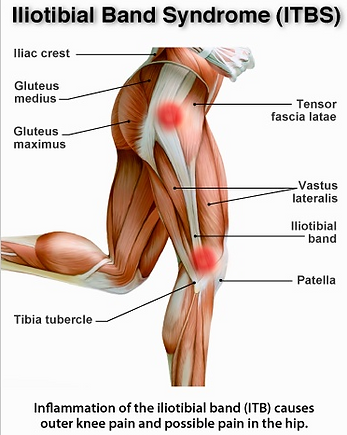BALANCE IN MOTION BODYWORK
Santa Barbara Massage & Pain Therapy
Illiotibial band or IT band pain is located on a band of dense connective tissue, known as fascia, which runs along the outside of both legs. It attaches to a small, but powerful, muscle called the Tensor Fascia Latae, or TFL for short. This muscle is located on the outside of your hip, and helps with flexing the hip, as well as rotates it inwards. On the bottom the IT Band attaches just below the knee, on its lateral surface. When the body is in perfect alignment and balance, these tissues won’t cause any problems, and most people don’t even know they are there. But once irritated, the IT band can cause a lot of pain and stiffness in the lateral leg and hip. It can also cause intense pain down at the knee, making it very difficult to perform simple activities, like climbing up or down stairs.
There are several causes of IT band irritation; a direct blow to the lateral leg, causing injury and swelling in the tissues. Another having very tight quadriceps, and hamstrings (the muscles on the front and back of leg). The most common cause of IT band irritation is TFL overuse.
The TFL is really just meant to assist larger muscles produce movement. But if the other muscles are dysfunctional and are not doing their job properly, the TFL will take over the load, and work twice as hard so that you can still do all the activities you want, without noticing any dysfunction.
Most commonly the TFL will be working overtime to cover up a deep hip flexor problem. This hip flexor is known as Iliopsoas. It is the primary hip flexor muscle, meaning it s responsible for lifting the hip up in a forward direction. The iliopsoas commonly gets very tight and chronically shortened due to prolonged sitting (work all day at a desk), and due to the type of muscle it is. In this chronically tight and shortened position it cannot produce a strong muscle contraction, and can become very weak, meaning it needs a little help from its neighbor, the TFL.
Iliotibial band (IT Band or ITB) Pain
The TFL can only handle so much before it gets overworked, and injured. Every time it contracts, it tugs and pulls on the IT band. The stronger the contraction, the stronger the tug. Eventually this can lead to irritation of the IT band itself, causing swelling and pain, down the lateral leg. This commonly occurs after you do something that requires A LOT of hip flexing, such as running, cycling, or hiking. This swelling, not only causes pain, but also causes scar tissue to develop in the irritated tissues, as well as the surrounding musculature. Scar tissue causes these tissues to become hard, tight and very inflexible. This lack of flexibility causes even more irritation to the TFL/IT Band because instead of stretching and moving like they should, they will actually microscopically tear, leading to more swelling, and scar tissue formation. Every time the TFL has to work overtime more and more damage is done, leading to a tighter and tighter TFL/IT band. You can now see how It Band problems become a chronic problem, especially in active people. Although a chronic problem, IT band Problems can be decreased, and in most cases fixed with proper intervention and treatment.
Massage therapy and the IT band
Massage therapy is an excellent method of treatment for IT Band problems. In most cases treatment will focus on releasing the tension and painful trigger points in the TFL, and then releasing the adhesions and scar tissue in the IT Band itself with Myofascial release.
For especially stubborn cases, we have also had great results with Barefoot massage which allows deep massage of the TFL and stretching of the fascia and Proprioceptive Deep Tendon Reflex Therapy (P-DTR), which reprograms the body to function properly..
Once the symptoms and tightness has decreased in the symptomatic tissues, it is important to get the cause of the problem addressed as well, or the symptoms may come back. In most cases the iliopsoas must be released manually with massage therapy, and myofascial release. When a muscle gets extremely tight and short, simple stretching usually won’t be enough to release the muscle, especially the iliopsoas.


